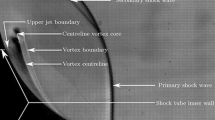Abstract
When a detonation wave emerges from a tube into unconfined space filled with a gas mixture, detonation wave diffraction occurs due to abrupt changes in the cross-sectional area. In the present study, we focused on the local explosion in reinitiation and propagation of a transverse detonation wave by performing comprehensive and direct observation with high time resolution visualization in a two-dimensional rectangular channel. Using the visualization methods of shadowgraph and multi-frame, short-time, open-shutter photography, we determined where the wall reflection point is generated, and also determined where the bright point is originated by the local explosion, and investigated the effects of the deviation angle and initial pressure of the gas mixture. We found that the reinitiation of detonation had two modes that were determined by the deviation angle of the channel. If the deviation angle was less than or equal to 30\(^{\circ }\), the local explosion of reinitiation might occur in the vicinity of the channel wall, and if the deviation angle was greater than or equal to 60\(^{\circ }\), the local explosion might originate on the upper side of the tube exit. With a deviation angle greater than 60\(^{\circ }\), the position of the wall reflection point depended on the cell width, so the radial distance of the wall reflection point from the apex of the tube exit was about 12 times the cell width. Similarly, the bright point (local explosion point) was located a distance of about 11 times the cell width from the apex of the tube exit, with a circumferential angle of 48\(^{\circ }\).

















Similar content being viewed by others
Abbreviations
- \(p_{0}\) :
-
Initial pressure of the gas mixture
- r :
-
Radial direction distance
- \(r_\mathrm{b}\) :
-
Radial direction distance of the bright point
- \(r_\mathrm{w}\) :
-
Radial direction distance of the wall reflection point
- \(T_{0}\) :
-
Temperature of the gas mixture
- u :
-
Fitting equation of the cell width
- V :
-
Velocity of the detonation wave at a given point
- \(V_\mathrm{CJ}\) :
-
Chapman–Jouguet velocity
- x :
-
Sample value of the cell width obtained from the Detonation Database
- \(\lambda \) :
-
Cell width
- \(\theta \) :
-
Circumferential angle
- \(\theta _\mathrm{d}\) :
-
Deviation angle of the channel
- \(\theta _\mathrm{b}\) :
-
Angle of the bright point
- \(\sigma \) :
-
Standard deviation of the cell width
References
Zeldovich, Ya.B., Kogarko, S.M., Simonov, N.N.: An experimental investigation of spherical detonation in gases. Sov. Tech. Phys. 1, 1689–1713 (1956)
Edwards, D.H., Thomas, G.O., Nettleton, M.A.: The diffraction of a planar detonation wave at an abrupt area change. J. Fluid Mech. 95, 79–96 (1979)
Murray, S.B., Lee, J.H.S.: On the transformation of planar detonation to cylindrical detonation. Combust. Flame 52, 269–289 (1983)
Lee, J.H.S.: The Detonation Phenomenon. Cambridge University Press, Cambridge (2008)
Khasainov, B., Presles, H.N., Desbordes, D., Demontis, P., Vidal, P.: Detonation diffraction from critical tubes to cones. Shock Waves 14(3), 187–192 (2005)
Bartlmä, F., Schröder, K.: The diffraction of a plane detonation wave at a convex corner. Combust. Flame 66, 237–248 (1986)
Pintgen, F., Shepherd, J.E.: Detonation diffraction in gases. Combust. Flame 156(3), 665–677 (2009)
Pintgen, F., Shepherd, J.E.: Stereoscopic imaging of transverse detonations in diffraction. J. Flow Vis. Imaging Process. 14, 121–142 (2007)
Shepherd, J.E., Schultz, E., Akbar, R.: Detonation diffraction. In: Proceedings of the 22nd International Symposium on Shock Waves, vol. 1, pp. 41–48 (2000)
Pintgen, F.: Detonation diffraction in mixtures with various degrees of instability, Ph.D. thesis. California Institute of Technology (2004)
Arienti, M., Shepherd, J.E.: A numerical study of detonation diffraction. J. Fluid Mech. 529, 117–146 (2005)
Nakayama, H., Moriya, T., Kasahara, J., Matsuo, A., Sasamoto, Y., Funaki, I.: Detonation wave propagation in annular channels with rectangular cross-section. Combust. Flame 159, 859–869 (2012)
Nagura, Y., Kasahara, J., Sugiyama, Y., Matsuo, A.: Comprehensive visualization of detonation-diffraction structure and sizes in unstable and stable mixtures. Proc. Combust. Inst. 34, 1949–1956 (2013)
Kudo, Y., Nagura, Y., Kasahara, J., Sasamoto, Y., Matsuo, A.: Oblique detonation waves stabilized in rectangular-cross-section bent tubes. Proc. Combust. Inst. 33, 2319–2326 (2011)
Skews, B.W.: The shape of a diffracting shock wave. J. Fluid Mech. 29, 297–304 (1967)
Whitham, G.B.: A new approach to problems of shock dynamics. Part 1. Two-dimensional problems. J. Fluid Mech. 2, 145–171 (1957)
Abid, S., Dupre, G., Paillard, C.: Oxidation of gaseous unsymmetrical dimethylhydrazine at high temperatures and detonation of UDMH/O\(_{2}\) mixtures. Prog. Astronaut. Aeronaut. 153, 162–181 (1991)
Knystautas, R., Lee, J.H.S., Guirao, C.: The critical tube diameter for detonation failure in hydrocarbon–air mixtures. Combust. Flame 48, 63–83 (1982)
Strehlow, R.A.: Transverse waves in detonations: II. Structure and spacing in H\(_{2}\)-O\(_{2}\), C\(_{2}\)H\(_{2}\)-O\(_{2}\), C\(_{2}\)H\(_{4}\)-O\(_{2}\) and CH\(_{4}\)-O\(_{2}\) systems. AIAA J. 7(3), 492–496 (1969)
Kaneshige, M., Shepherd, J.E.: Detonation Database. Technical Report FM97-8, GALCIT (1997). http://www.galcit.caltech.edu/detn_db/html/
Acknowledgments
This work was subsidized by the Ministry of Education, Culture, Sports, Science and Technology, a Grant-in-Aid for Scientific Research (A), No. 21360411; a Grant-in-Aid for Scientific Research (B), No. 20241040; and the Research Grant Program from the Institute of Space and Astronautical Science, the Japan Aerospace Exploration Agency. Finally, the authors would like to thank Y. Kudo for his advice and assistance in designing and manufacturing the experimental setup.
Author information
Authors and Affiliations
Corresponding author
Additional information
Communicated by S. Dorofeev and A. Higgins.
Rights and permissions
About this article
Cite this article
Nagura, Y., Kasahara, J. & Matsuo, A. Multi-frame visualization for detonation wave diffraction. Shock Waves 26, 645–656 (2016). https://doi.org/10.1007/s00193-016-0663-y
Received:
Revised:
Accepted:
Published:
Issue Date:
DOI: https://doi.org/10.1007/s00193-016-0663-y




